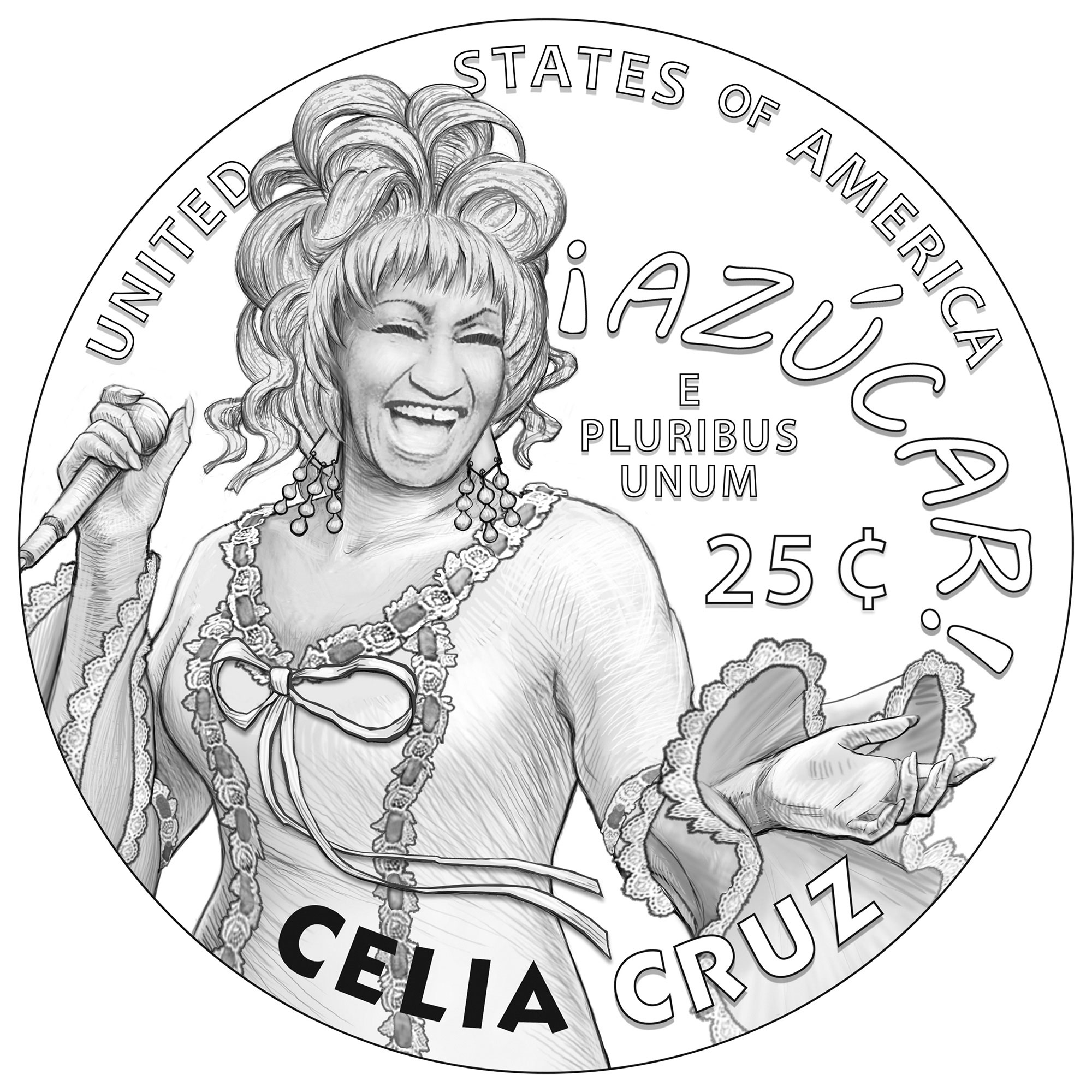Although Americans will have to wait until 2024 to get their hands on the new Celia Cruz quarter, the highly-anticipated design has finally been unveiled. The quarter's design, which was released in late July, features a joyous Cruz, donning a Cuban Rumba dress with a mic in hand and her signature phrase “Azúcar!” inscribed on it.
The coin honoring the late three-time Grammy-award winning artist is part of this year’s American Women Quarters Program, which selects five women a year (from 2022-2025) to be featured on the reverse side of a quarter. Other recipients include Dr. Mary Edwards Walker, the first female U.S. army surgeon during the Civil War, and Patsy Takemoto Mink, the first woman of color elected to the U.S. Congress.
U.S. medallic artist Phebe Hemphill, who began designing Cruz’s coin this spring, had the honor of working on the first-ever coin to feature an Afro-Latina. Cruz, the “Queen of Salsa,” was one of few women who became successful in the male-dominated genre of music throughout the mid-to late 1900s. Hemphill describes Cruz as a “colorful, dynamic person” and she wanted to make that apparent in her design.
“Obviously she was a superstar and a hero to many people so I I felt that I had to give the coin a little bit more character than a normal portrait,” Hemphill says.
TIME spoke to Hemphill about creating the coin’s design.

The coin making process
Hemphill says the process for designing the coin was laborious. A few U.S. Mint medallic artists were tasked with working on the design project for a coin to honor Cruz during the month of March. Artists conducted their own research on the honoree, but also participated in a kick-off call with Omer Pardillo, Cruz’s former manager and executor of her estate. Pardillo worked as a liaison during the brainstorming and design process.
“I looked at her BBC documentary, I listened to a lot of her music from YouTube, and I tried to get a sense of who she was,” Hemphill says. Hemphill also consulted with the Smithsonian Women’s History Museum and the National Women’s History Museum to provide feedback. Dr. Ariana Curtis, Curator of Latinx Studies from the National Museum of African American History and Culture, also helped consult on the historical accuracy of the image.
The design process functions as a sort of competition, with artists having a few weeks to create a digital design of the quarter. Six designs were submitted for consideration. The U.S. Mint, Hemphill says, does the first internal review of the designs before submitting images to the Citizens Coinage Advisory Committee (CCAC), which advises on all U.S. coins and medals, and the Committee of Fine Art (CFA). The CFA and CCAC submit the design they feel best embodies the honoree, though the ultimate decision falls to the U.S. Secretary of the Treasury Janet Yellen. She chose Hemphill’s work.
Hemphill, who had the rare opportunity to be both the designer and sculptor of the coin, said she was not as familiar with Cruz (though she thinks her grandparents may have seen her perform during their visit to Cuba in the 1950s) but was “tremendously impressed” by the footage she saw.
Hemphill says her design went through a few refinements, before she spent the next three weeks sculpting the actual coin with hard clay on an eight-inch diameter circle. “I sculpted the basic figure with the dress, and the hand, and the microphone and the hair without all the detail on the dress,” Hemphill says. The sculpture is then scanned before Hemphill makes final adjustments digitally. “The dress, the fringe, the earrings…[those are] technical adjustments that…are all done in software.”
Working on an iconic coin
Hemphill, who has also worked on crafting coins honoring Grand Canyon National Park for the 2010 America the Beautiful Quarters Program and the 2011 Fallen Heroes of 9/11 Congressional Gold Medals, says she is nervous and excited about the design. “It's super daunting,” she says. “I hope it's well received, and I hope people like the work that I've done. And if that's the case, then I'll be very happy.”
Cruz is an iconic figure for Latinos both in the U.S. and abroad. The Cuban-born singer is remembered for her contributions to the genre of salsa, increasing its popularity and cementing it as one of the most popular genres of Latin music.
“It's a significant honor to become the first Afro-Latina, who, despite her humble beginnings, managed to captivate the world with her exceptional talent and charisma,” Pardillo wrote to TIME in a statement.
“All Latinos should be very proud of this enormous accomplishment as Celia, not only represents Cubans but Latinos all over the world,” Pardillo added. “She belonged to the world.”
More Must-Reads from TIME
- Caitlin Clark Is TIME's 2024 Athlete of the Year
- Where Trump 2.0 Will Differ From 1.0
- Is Intermittent Fasting Good or Bad for You?
- The 100 Must-Read Books of 2024
- Column: If Optimism Feels Ridiculous Now, Try Hope
- The Future of Climate Action Is Trade Policy
- FX’s Say Nothing Is the Must-Watch Political Thriller of 2024
- Merle Bombardieri Is Helping People Make the Baby Decision
Contact us at letters@time.com